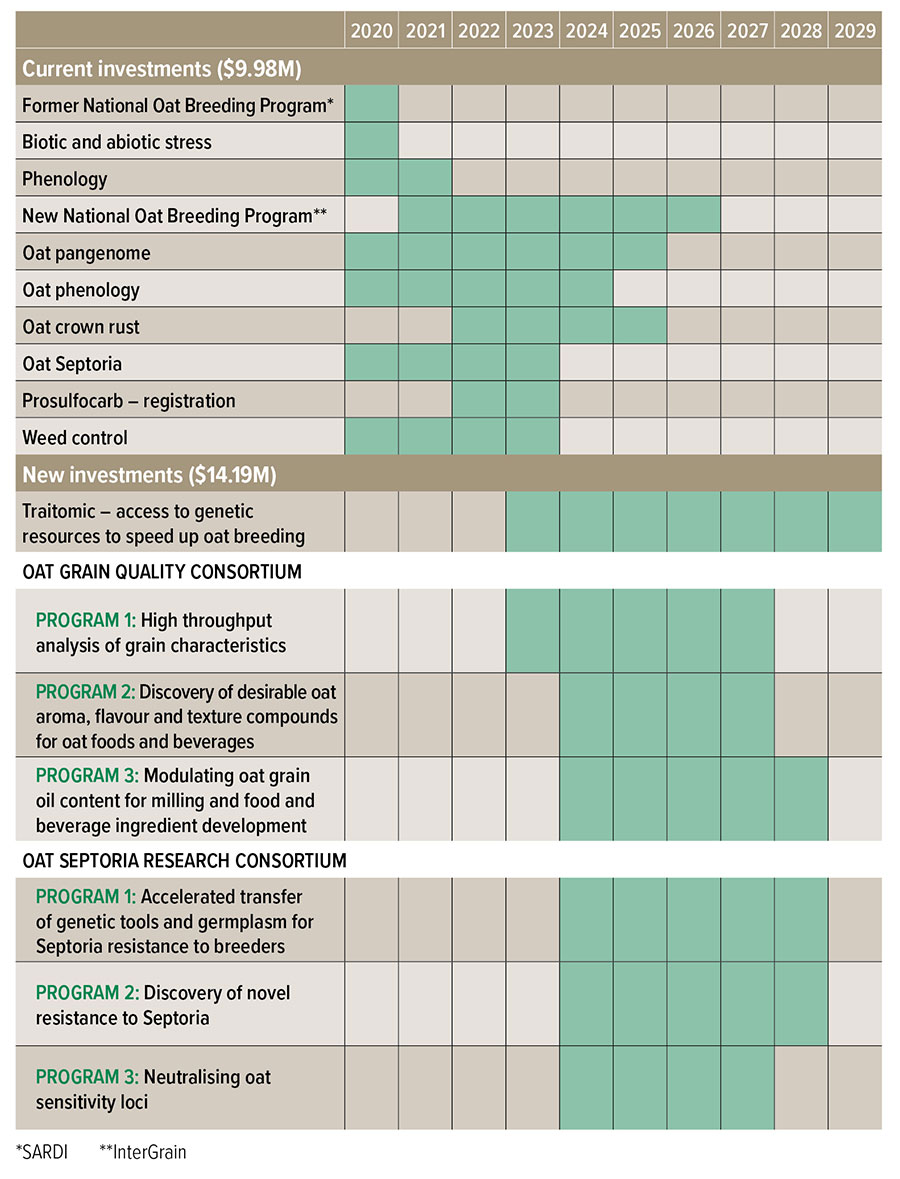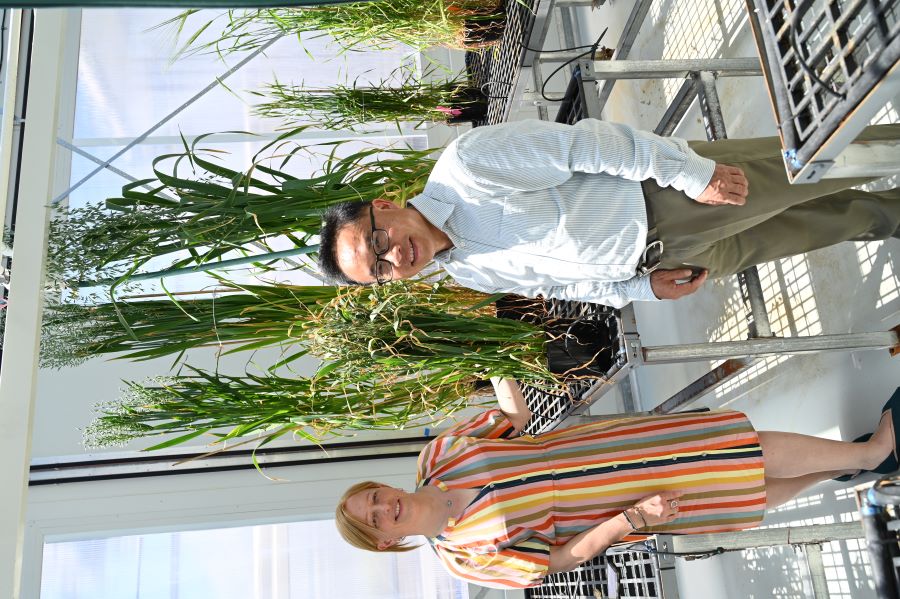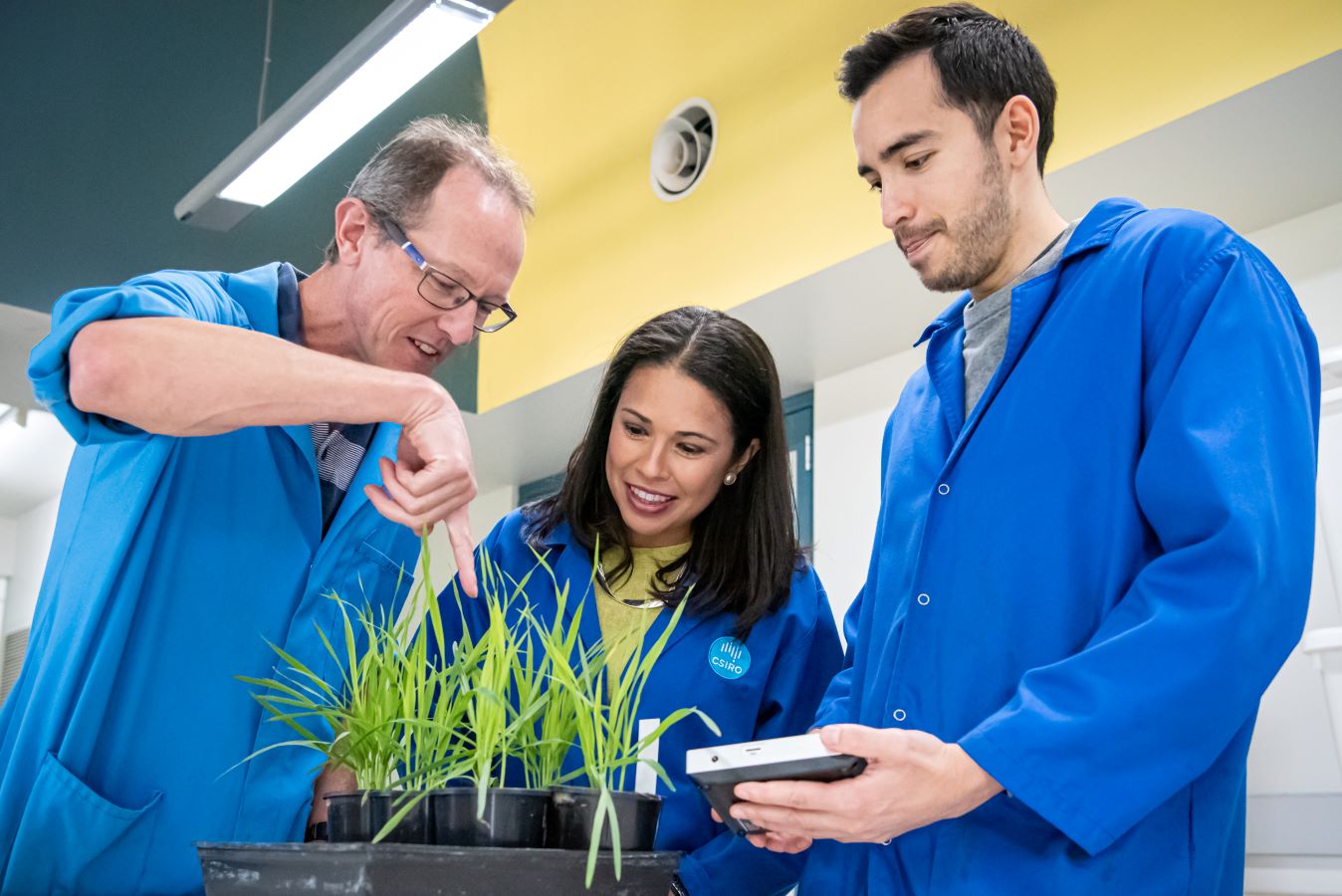Seizing opportunities in expanding oat markets, GRDC is boosting oat investment by leveraging a strong research foundation.
Oat consumption in food and beverages is driving unprecedented global demand, with a five per cent annual growth in global markets expected in the next five years.
To capitalise on these developments, GRDC has launched a new wave of R&D investments to position Australian growers to capture a greater market share.
GRDC Chair and Goondiwindi grain grower John Woods says; “We know that the global demand for diverse and nutritious oat-based products is on the rise and there is a clear opportunity for Australian agriculture to lead the way in quality and sustainability. This is why GRDC has initiated and invested in a series of new oat investments on behalf of Australian growers.”
Coordinating these investments is GRDC genetic technologies manager (barley, oats and sorghum) Dr Michael Groszmann, who says;
“GRDC’s new wave of oat investments has been designed strategically with industry partners, using market insights and rides on prior investments, which include the new National Oat Breeding Program under the leadership of InterGrain, the oat pangenome (Murdoch University) and oat phenology research (CSIRO).”
Table 1 shows the nature of the $24 million that GRDC has so far invested in oat improvement this decade alone. These investments receive considerable co-investment by research institutions and increasing industry partner engagement.
Table : GRDC oat investments

“Two new consortia – the Oat Grain Quality Consortium (OGQC) and the Oat Septoria Research Consortium (OSRC) – form substantial parts of the $14 million new wave of investments, together with an innovative trait development company, Traitomic, based in Denmark,” Dr Groszmann says.
 Dr Michael Groszmann, GRDC genetic technologies manager (barley, oats and sorghum) is coordinating both the Oat Grain Quality Consortium and Oat Septoria Research Consortium. Photo: courtesy of Michael Groszmann
Dr Michael Groszmann, GRDC genetic technologies manager (barley, oats and sorghum) is coordinating both the Oat Grain Quality Consortium and Oat Septoria Research Consortium. Photo: courtesy of Michael Groszmann
“This portfolio of research will benefit the entire Australian oat supply chain by providing breeders with new traits that align with market demands, improving efficiency and reducing costs for processors, and expanding the range of oat-based products that manufacturers can offer consumers.”
The Oat Grain Quality Consortium
The OGQC aims to capitalise on international demand in oats for food and beverage applications via targeted pre-breeding through three programs of activity, each supporting Australian oat pre-breeding research to understand the molecular and biochemical control of key oat quality traits.
Researchers will work with oat millers and food and beverage processors to develop industry-relevant thresholds for traits such as groat oil, beta-glucan and protein, and work with breeding programs to identify and provide germplasm and molecular tools to rapidly develop new oat varieties suited to high-value end-use market requirements.
“By innovating across breeding, measurement, quality and nutritional content, we can set new standards that drive value-added opportunities for milling oats,” Dr Groszmann says.
The three programs of the consortium bring together a diverse group of organisations spanning the research, production, processing, and food and beverage manufacturing sectors, each contributing their expertise to driving industry transformation. (See inset box for further details.)
Program 1: Accelerating the development of an accurate and cost-effective high-throughput measurement method for key oat quality characteristics.
Led by research partner InterGrain and with co-investment from the WA State Government Processed Oat Partnership program (giwa.org.au/pop).
Program 2: Discovery of desirable aroma, flavour and texture compounds for oat food/beverage applications.
Led by research partner InterGrain in collaboration with Curtin University, Murdoch University, Edith Cowan University, Agriculture Victoria, Shaanxi Normal University, plus industry partners Unigrain, Wide Open Agriculture, Fancy Plants, Oatly, Sanitarium, Uncle Toby’s, Blue Lake Milling, Quaker, Noumi, Seamild and the Australian Export Grains Innovation Centre (AEGIC).
Program 3: Modulating grain oil content of oats to improve suitability for milling and food/beverage ingredient development.
Led by research partner the South Australian Research and Development Institute (SARDI) in collaboration with the University of Adelaide, University of South Australia and InterGrain, plus industry partners Unigrain, AEGIC and Grains Australia Ltd.
Australian oat research needs for key food and beverage quality characteristics
Beta-glucan
Oat beta-glucan offers diverse health benefits, including reducing cardiovascular disease risks, inflammation and type 2 diabetes. To market foods with wholegrain oats in Australia for their health benefits they must contain at least one gram per serving of beta-glucan, equivalent to four per cent in the grain. As beta-glucan also influences oat milk viscosity, it becomes an additional quality factor of value to markets. A standardised beta-glucan measurement method is crucial for international and national oat market growth and will aid Australian breeders in enhancing beta-glucan content.
‘Taste’ compounds – flavour and aroma
Oat flavour and aroma are influenced by a range of factors including: (1) the intrinsic flavour and aroma profile of individual oat varieties, and (2) the positive and negative flavours attributable to processing activities, in particular heat treatment. While major oat customers prioritise flavour and aroma, knowledge gaps exist in the understanding of what compounds are involved, their genetic and environmental control, together with the effects processing can have on them. Understanding these factors is crucial for developing oats tailored for various uses such as noodle production and new beverage options.
Groat oil content
Animal feed markets favour oats varieties high in protein and oil and low in fibre for their increased energy. Human food markets, however, prefer oats with lower oil content to avoid rancidity and extend shelf life. High oil content also makes oats harder to mill compared to other grains. Developing oats with reduced oil content could expand their uses in Australia and improve their suitability for other processing applications.
“This initiative will use the scale and magnitude of the InterGrain oat breeding program to create tools that will aid in quantifying oat quality traits for industry classification, via Grains Australia receival points assessment,” says Dr Dini Ganesalingam, InterGrain’s research and business development manager who is leading Program 1.
“Importantly, it will aid in the setting and maintaining of breeding targets,” she says.
InterGrain cereal chemist Dr Haelee Fenton is leading the trait selection intelligence of ‘taste’ compounds determining aroma and flavour in oat foods and beverages.
“We’re excited about leading the research discovery of these compounds, which will be integral to setting targets for InterGrain’s oat breeding program,” Dr Fenton says.
According to the leader of Program 3, SARDI crop and pasture improvement program leader Dr Janine Croser, the initiative has the potential to be truly transformative for Australian oat quality and production research.
“Enhancing shelf life and milling efficiency may open new avenues for Australian oats in global markets – something that SARDI will be exploring intently in conjunction with our industry consultative committee and research partners,” Dr Croser says.
Dr Groszmann says market intelligence is being provided by AEGIC, which will enable Australian oats to be positioned to capitalise on international market developments. “Importantly, the OGQC could also help inform decisions made by Grains Australia’s Oat Council on its new oat classification framework,” he says.
Oat Septoria Research Consortium
Septoria avenae leaf blotch is the oat disease with the greatest impact on yields, often resulting in a 10 to 15 per cent loss in grain yield potential. It is stubble-borne and particularly problematic in high-rainfall regions where oats are more frequently grown.
Australian oat varieties have poor genetic resistance to the disease. Growers rely on cultural practices and chemical measures to control it. These come with an economic cost to growers, prolong crop rotations, and chemical use alone is not sustainable because of the risk of reduced efficacy and market pressures to reduce its use.
In 2020, GRDC invested $800,000 over three years with SARDI in a discovery program to try and identify sources of resistance to oat Septoria and understand the evolution and virulence of the pathogen. This investment was part of the first wave of oat investments in the 2020s (Table 1). It has delivered essential initial tools and resources towards combating Septoria.
To close gaps in the knowledge of Septoria and alleviate constraints, Dr Groszmann is coordinating further research efforts of GRDC with the commencement of the OSRC.
“With this consortium we are focusing on identifying more resistance sources, scrutinising the value of these sources across environments and seasons, refining in-lab phenotyping of the pathogen and generating molecular tools for breeders,” he says.
“If we can better understand the pathogen virulence mechanisms at the genomic level it will enable improved identification of novel resistance mechanisms in the oat plant host.
“These components of the consortium will be delivered through three programs that will see Australia’s leading oat Septoria research groups unite in a consolidated effort to enable industry deployment of new high-yielding oat varieties that are highly resistant to oat Septoria, allowing growers to minimise reliance on fungicides to reduce costs, ensure functional chemistry remains in reserve if needed, and safeguard the oat industry against market changes that may limit use/access of fungicides.
“Each consortium member has unrivalled expertise, resources, capabilities, and capacity in the oat Septoria research space that would be synergised in a collaborative network, and together represent the best opportunity to accelerate delivery of effective solutions against Septoria avenae leaf blotch for growers and industry.”
Program 1 – Accelerating transfer of resistant sources to Australian oat breeders.
Led by SARDI under the management of Drs Judith Atieno and Janine Croser.
Program 2 – Further discovery of improved sources of Septoria resistance
Led by a DPIRD/Murdoch University collaboration under the management of Dr Chengdao Li, Manisha Shankar and Darshan Sharma.
Program 3 – Identification of oat sensitivity loci corresponding to newly discovered fungal effectors.
Led by Curtin University’s Centre for Crop and Disease Management under the management of Dr Huyen Phan and Professor Mark Gibberd.
New oat trait generation
GRDC has brought another new partnership to the oat advancement tool kit through partnering with Danish crop trait development company Traitomic. This investment will also benefit Australian lupins, giving access for breeders of both crops to vast libraries of genetic variants. This will accelerate the pace that researchers and breeders identify and incorporate genes for key traits such as grain quality, disease resistance and environmental adaptation into elite crop varieties.
 Agnieszka Nielsen of Traitomic and Professor Chengdao Li of Murdoch University with Australian oat variety Bilbyin the foreground. Photo: Sue Knights
Agnieszka Nielsen of Traitomic and Professor Chengdao Li of Murdoch University with Australian oat variety Bilbyin the foreground. Photo: Sue Knights
“Initially the partnership will enable GRDC breeding and pre-breeding research partners to access genetic libraries in elite oat and lupin cultivars to generate and identify new versions of genes with bespoke enhanced functions of interest,” Dr Groszmann says.
Traitomic brings expertise in plant seed and microbial strain development for the food industry. Its resources and services allow for the generation and evaluation of tailored gene variants that can give rise to unique traits, without the need for genetic modification. This means that the gene variants provided by Traitomic are non-GMO and free from regulatory constraints, allowing for their rapid integration into breeding programs. This provides new avenues for breeders to develop crops with enhanced traits that might not be available through traditional breeding methods.
Oat crown rust update
In recent years, GRDC has upped the ante with investments to address another significant oat disease – oat crown rust. This new investment, with Professor Melania Figueroa’s team at CSIRO, is building on the formative work undertaken at the University of Sydney. Professor Figueroa has relocated with her team from the US to CSIRO, Canberra, bringing international experience and new technology to unearth important new insights about this complex disease in Australia.
“This new GRDC project has enabled us to assemble a valuable collection of oat crown rust isolates from environments across Australia,” Professor Figueroa says.
 Professor Melania Figueroa (centre) with two members of the CSIRO Oat Crown Rust research team, David Lewis (research project officer, left) and Dr Tim Hewitt (former CSIRO CERC postdoctoral fellow). Photo: CSIRO
Professor Melania Figueroa (centre) with two members of the CSIRO Oat Crown Rust research team, David Lewis (research project officer, left) and Dr Tim Hewitt (former CSIRO CERC postdoctoral fellow). Photo: CSIRO
“As NextGengenetic tools have become more affordable, we are able to apply them to crops such as oats, generating molecular level insights into both the fungi and disease resistance status of oat varieties.”
“Using these tools we have described 289 oat crown rust isolates across Australia and learnt that virulence differs between eastern and western Australia isolates, with the eastern ones being more virulent. We are learning a lot about how this pathogen is evolving in Australia and the contrast with other parts of the world.”
In parallel, Professor Figueroa’s team is interrogating Australian oat diversity for resistance genes and learning that there is an urgent need to expand the sources of resistance. Her team has imported oat germplasm from North America to address this shortage and is working intensively in helping Australia to adopt molecular marker technology to track resistance. More resistance genes, together with new genomic breeding technologies being implemented by InterGrain’s national oat breeding program, will accelerate the development of resistant varieties for Australian growers.
If you suspect oat crown rust has infected your crops this year, please send freshly collected samples to Melania Figueroa, CSIRO, GPO Box 1700, Canberra, ACT, 2601. For information on samples preparation go to:
This new era for Australian oats has been dubbed the era of ‘Porridge Plus’ for Australian oats by InterGrain oat breeder Dr Allan Rattey.
“It is exciting to be part of a concerted and coordinated wave of investments that will be formative in boosting the rate of breeding improvement we can achieve with oats. This will ensure oats flourish in Australian growing conditions and capture market opportunities to deliver increased value across the industry,” Dr Rattey says.
GRDC’s commitment to expanding the scope for oats remains steadfast. This effort is not only aimed at aligning with market trends and the evolving oat classification standards, but also at enhancing the crop’s performance. With ongoing investments in environmental adaptation and weed management in the pipeline, GRDC is poised to elevate the oat industry’s potential for the benefit of Australian growers.
More information: Dr Michael Groszmann, michael.groszmann@grdc.com.au

























































